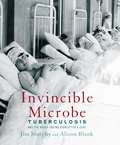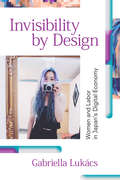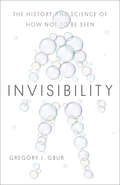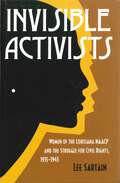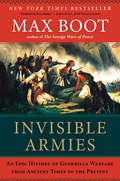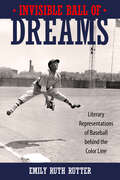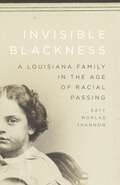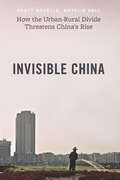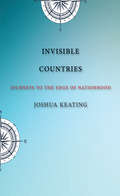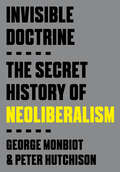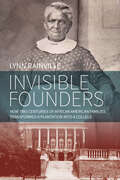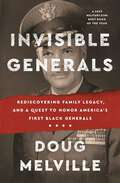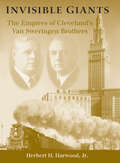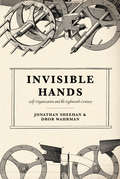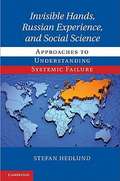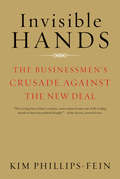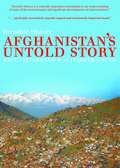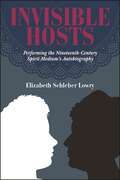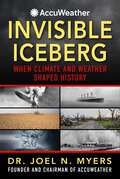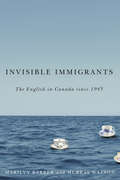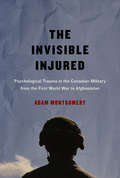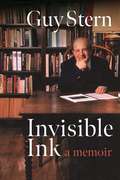- Table View
- List View
Invincible Microbe: Tuberculosis and the Never-Ending Search for a Cure
by Jim Murphy Alison BlankThis is the story of a killer that has been striking people down for thousands of years:tuberculosis. After centuries of ineffective treatments, the microorganism that causesTB was identified, and the cure was thought to be within reach--but drug-resistantvarieties continue to plague and panic the human race. The "biography" of this deadlygerm, an account of the diagnosis, treatment, and "cure" of the disease over time,and the social history of an illness that could strike anywhere but was most prevalentamong the poor are woven together in an engrossing, carefully researched narrative.Bibliography, source notes, index.
Invisibility by Design: Women and Labor in Japan's Digital Economy
by Gabriella LukácsIn the wake of labor market deregulation during the 2000s, online content sharing and social networking platforms were promoted in Japan as new sites of work that were accessible to anyone. Enticed by the chance to build personally fulfilling careers, many young women entered Japan's digital economy by performing unpaid labor as photographers, net idols, bloggers, online traders, and cell phone novelists. While some women leveraged digital technology to create successful careers, most did not. In Invisibility by Design Gabriella Lukács traces how these women's unpaid labor became the engine of Japan's digital economy. Drawing on interviews with young women who strove to sculpt careers in the digital economy, Lukács shows how platform owners tapped unpaid labor to create innovative profit-generating practices without employing workers, thereby rendering women's labor invisible. By drawing out the ways in which labor precarity generates a demand for feminized affective labor, Lukács underscores the fallacy of the digital economy as a more democratic, egalitarian, and inclusive mode of production.
Invisibility: The History and Science of How Not to Be Seen
by Gregory J. GburA lively exploration of how invisibility has gone from science fiction to fact Is it possible for something or someone to be made invisible? This question, which has intrigued authors of science fiction for over a century, has become a headline-grabbing topic of scientific research. In this book, science writer and optical physicist Gregory J. Gbur traces the science of invisibility from its sci-fi origins in the nineteenth-century writings of authors such as H. G. Wells and Fitz James O&’Brien to modern stealth technology, invisibility cloaks, and metamaterials. He explores the history of invisibility and its science and technology connections, including the discovery of the electromagnetic spectrum, the development of the atomic model, and quantum theory. He shows how invisibility has moved from fiction to reality, and he questions the hidden paths that lie ahead for researchers. This is not only the story of invisibility but also the story of humankind&’s understanding of the nature of light itself, and of the many fascinating figures whose discoveries advanced this knowledge.
Invisible Activists: Women of the Louisiana NAACP and the Struggle for Civil Rights, 1915–1945 (Conflicting Worlds: New Dimensions of the American Civil War)
by Lee SartainBehind the historical accounts of the great men of the National Association for the Advancement of Colored People lies the almost forgotten story of the black women who not only participated in the organization but actually helped it thrive in the early twentieth-century South. In Invisible Activists, Lee Sartain examines attitudes toward gender, class, and citizenship of African American activists in Louisiana and women's roles in the campaign for civil rights in the state. In the end, he argues, it was women working behind the scenes in Louisiana's branches of the NAACP who were the most crucial factor in the organization's efficiency and survival. During the first half of the twentieth century -- especially in the darkest days of the Great Depression, when membership waned and funds were scarce -- a core group of women maintained Louisiana's NAACP. Fighting on the front line, Sartain explains, women acted as grassroots organizers, running public relations campaigns and membership drives, mobilizing youth groups, and promoting general community involvement. Using case studies of several prominent female NAACP members in Louisiana, Sartain demonstrates how women combined their fundraising skills with an extensive network of community and family ties to fund the NAACP and, increasingly, to undertake the day-to-day operations of the local organizations themselves. Still, these women also struggled against the double obstacles of racism and sexism that prevented them from attaining the highest positions within NAACP branch leadership. Sartain illustrates how the differences between the sexes were ultimately woven into the political battle for racial justice, where women were viewed as having inherent moral superiority and, hence, the potential to lift the black population as a whole. Sartain concludes that despite the societal traditions that kept women out of leadership positions, in the early stages of the civil rights movement, their skills and their contributions as community matriarchs provided the keys to the organization's progress. Highly original and essential to a comprehensive study of the NAACP, Invisible Activists gives voice to the many individual women who sustained the influential civil rights organization during a time of severe racial oppression in Louisiana. Without such dedication, Sartain asserts, the organization would have had no substantial presence in the state.
Invisible Armies: An Epic History of Guerrilla Warfare from Ancient Times to the Present
by Max Boot"Destined to be the classic account of what may be the oldest . . . hardest form of war."--John Nagl, Wall Street Journal Invisible Armies presents an entirely original narrative of warfare, which demonstrates that, far from the exception, loosely organized partisan or guerrilla warfare has been the dominant form of military conflict throughout history. New York Times best-selling author and military historian Max Boot traces guerrilla warfare and terrorism from antiquity to the present, narrating nearly thirty centuries of unconventional military conflicts. Filled with dramatic analysis of strategy and tactics, as well as many memorable characters--from Italian nationalist Guiseppe Garibaldi to the "Quiet American," Edward Lansdale--Invisible Armies is "as readable as a novel" (Michael Korda, Daily Beast) and "a timely reminder to politicians and generals of the hard-earned lessons of history" (Economist).
Invisible Ball of Dreams: Literary Representations of Baseball behind the Color Line
by Emily Ruth RutterWinner of the 2018 John Coates Next Generation Award from the Negro Leagues Research Committee of the Society for American Baseball Research Although many Americans think of Jackie Robinson when considering the story of segregation in baseball, a long history of tragedies and triumphs precede Robinson’s momentous debut with the Brooklyn Dodgers. From the pioneering Cuban Giants (1885-1915) to the Negro Leagues (1920-1960), Black baseball was a long-standing staple of African American communities. While many of its artifacts and statistics are lost, Black baseball figured vibrantly in films, novels, plays, and poems. In Invisible Ball of Dreams: Literary Representations of Baseball behind the Color Line, author Emily Ruth Rutter examines wide-ranging representations of this history by William Brashler, Jerome Charyn, August Wilson, Gloria Naylor, Harmony Holiday, Kevin King, Kadir Nelson, and Denzel Washington, among others. Reading representations across the literary color line, Rutter opens a propitious space for exploring Black cultural pride and residual frustrations with racial hypocrisies on the one hand and the benefits and limitations of white empathy on the other. Exploring these topics is necessary to the project of enriching the archives of segregated baseball in particular and African American cultural history more generally.
Invisible Blackness: A Louisiana Family in the Age of Racial Passing
by Katy Morlas ShannonInvisible Blackness explores the complex lives of Creoles of mixed race born in Louisiana to enslaved women and the white men who enslaved them. Individuals such as Alice Thomasson Grice forged their own identities—and often reinvented themselves—within the increasingly strict racial order of antebellum and postbellum Louisiana.Alice Thomasson Grice occupied an unusual position among mixed-race Creoles of her era, as her white father recognized her formerly enslaved mother as his wife and raised Alice and her siblings as free people. After Alice married a white steamboat captain, Charles Grice, she and her children chose to identify as white. Invisible Blackness explores why Alice, her children, and friends in similar positions elected to cross the color line during the so-called “great age of passing” that spanned from 1880 to 1925.While it’s impossible to quantify the number of people who crossed the color line at any given time, evidence suggests that the rate of passing corresponded closely with the severity of anti-Black oppression and discrimination. By the 1890s, when the Supreme Court upheld Jim Crow laws and lynchings were on the rise, Black people who could pass had a strong motivation to do so. For the Grices, passing afforded the only means of social, economic, and political advancement available to them.Drawing on a vast array of primary sources, ranging from sacramental records and bills of sale to wills and military pension files, Invisible Blackness sheds light on how this liminal group of individuals defined themselves and shaped their identities. The lives of the Grices and people like them underscore that race is both a social construct and a significant lived reality. Beyond these broad, pressing historical questions lie issues of love, family, and the universal quest for belonging that transcend time, place, and race.
Invisible China: How the Urban-Rural Divide Threatens China’s Rise
by Scott Rozelle Natalie HellAs the glittering skyline in Shanghai seemingly attests, China has quickly transformed itself from a place of stark poverty into a modern, urban, technologically savvy economic powerhouse. But as Scott Rozelle and Natalie Hell show in Invisible China, the truth is much more complicated and might be a serious cause for concern. China’s growth has relied heavily on unskilled labor. Most of the workers who have fueled the country’s rise come from rural villages and have never been to high school. While this national growth strategy has been effective for three decades, the unskilled wage rate is finally rising, inducing companies inside China to automate at an unprecedented rate and triggering an exodus of companies seeking cheaper labor in other countries. Ten years ago, almost every product for sale in an American Walmart was made in China. Today, that is no longer the case. With the changing demand for labor, China seems to have no good back-up plan. For all of its investment in physical infrastructure, for decades China failed to invest enough in its people. Recent progress may come too late. Drawing on extensive surveys on the ground in China, Rozelle and Hell reveal that while China may be the second-largest economy in the world, its labor force has one of the lowest levels of education of any comparable country. Over half of China’s population—as well as a vast majority of its children—are from rural areas. Their low levels of basic education may leave many unable to find work in the formal workplace as China’s economy changes and manufacturing jobs move elsewhere. In Invisible China, Rozelle and Hell speak not only to an urgent humanitarian concern but also a potential economic crisis that could upend economies and foreign relations around the globe. If too many are left structurally unemployable, the implications both inside and outside of China could be serious. Understanding the situation in China today is essential if we are to avoid a potential crisis of international proportions. This book is an urgent and timely call to action that should be read by economists, policymakers, the business community, and general readers alike.
Invisible Cities
by William Weaver Italo CalvinoImaginary conversations between Marco Polo and his host, the Chinese ruler Kublai Khan, conjure up cities of magical times. "Of all tasks, describing the contents of a book is the most difficult and in the case of a marvelous invention like Invisible Cities, perfectly irrelevant" (Gore Vidal). Translated by William Weaver. A Helen and Kurt Wolff Book. Unusual Table of Contents and presentation.
Invisible Countries: Journeys to the Edge of Nationhood
by Joshua KeatingA journalist explores how our world&’s borders came to be and how self-proclaimed countries across the globe could change the map. What is a country? While certain basic criteria—borders, a government, and recognition from other countries—seem obvious, journalist Joshua Keating investigates what happens in areas of the world that exist as exceptions to these rules. Invisible Countries looks at semiautonomous countries such as Abkhazia, Kurdistan, and Somaliland, as well as a Mohawk reservation straddling the U.S.-Canada border, and an island nation whose very existence is threatened by climate change. Through stories about these would-be countries&’ efforts at self-determination, Keating shows that there is no universal legal authority determining what a country is. He also argues that economic, cultural, and environmental forces could soon bring an end to our long period of cartographical stasis. Keating combines history with incisive observations drawn from his travels and interviews with residents, political leaders, and scholars in each of these &“invisible countries.&”
Invisible Doctrine: The Secret History of Neoliberalism
by George Monbiot Peter Hutchison#1 SUNDAY TIMES BESTSELLER • A sharp, fiercely argued takedown of neoliberalism that not only defines this slippery concept but connects it to the climate crisis, poverty, and fascism—and shows us how to fight back.&“Incisive, illuminating, eye-opening—an unsparing anatomy of the great ideological beast stalking our times, often whispered about and yet never so clearly in view.&”—David Wallace-Wells, author of The Uninhabitable EarthNeoliberalism is the dominant ideology of our time. It shapes us in countless ways, yet most of us struggle to articulate what it is. Worse, we have been persuaded to accept this extreme creed as a kind of natural law. In Invisible Doctrine, journalist George Monbiot and filmmaker Peter Hutchison shatter this myth. They show how a fringe philosophy in the 1930s—championing competition as the defining feature of humankind—was systematically hijacked by a group of wealthy elites, determined to guard their fortunes and power. Think tanks, corporations, the media, university departments and politicians were all deployed to promote the idea that people are consumers, rather than citizens.One of the most pernicious effects has been to make our various crises—from climate disasters to economic crashes, from the degradation of public services to rampant child poverty—seem unrelated. In fact, they have all been exacerbated by the &“invisible doctrine,&” which subordinates democracy to the power of money. Monbiot and Hutchison connect the dots—and trace a direct line from neoliberalism to fascism, which preys on people&’s hopelessness and desperation.Speaking out against the fairy tale of capitalism and populist conspiracy theories, Monbiot and Hutchison lay the groundwork for a new politics, one based on truly participatory democracy and &“private sufficiency, public luxury&”: an inspiring vision that could help bring the neoliberal era to an end.
Invisible Enlighteners: The Jewish Merchants of Modena, from the Renaissance to the Emancipation (Jewish Culture and Contexts)
by Federica FrancesconiFederica Francesconi writes the history of the Jewish merchants who lived and prospered in the northern Italian city of Modena, capital city of the Este Duchy, during the seventeenth and eighteenth centuries. Her protagonists are men and women who stood out within their communities but who, despite their cultural and economic prominence, were ghettoized after 1638. Their sociocultural transformation and eventual legal and political integration evolved through a complex dialogue between their Italian and Jewish identities, and without the traumatic ruptures or dramatic divides that led to the assimilation and conversion of many Jews elsewhere in Europe.In Modena, male and female Jewish identities were contoured by both cultural developments internal to the community and engagement with the broader society. The study of Lurianic and Cordoverian Kabbalah, liturgical and nondevotional Hebrew poetry, and Sabbateanism existed alongside interactions with Jesuits, converts, and inquisitors. If Modenese Jewish merchants were absent from the public discourse of the Estes, their businesses lives were nevertheless located at the very geographical and economic center of the city. They lived in an environment that gave rise to unique forms of Renaissance culture, early modern female agency, and Enlightenment practice. New Jewish ways of performing gender emerged in the seventeenth century, giving rise to what could be called an entrepreneurial female community devoted to assisting, employing, and socializing in the ghetto. Indeed, the ghetto leadership prepared both Jewish men and women for the political and legal emancipation they would eventually obtain under Napoleon. It was the cultured Modenese merchants who combined active participation in the political struggle for Italian Jewish emancipation with the creation of a special form of the Enlightenment embedded in scholarly and French-oriented lay culture that emerged within the European context.
Invisible Founders: How Two Centuries of African American Families Transformed a Plantation into a College
by Lynn RainvilleLiteral and metaphorical excavations at Sweet Briar College reveal how African American labor enabled the transformation of Sweet Briar Plantation into a private women’s college in 1906. This volume tells the story of the invisible founders of a college founded by and for white women. Despite being built and maintained by African American families, the college did not integrate its student body for sixty years after it opened. In the process, Invisible Founders challenges our ideas of what a college “founder” is, restoring African American narratives to their deserved and central place in the story of a single institution — one that serves as a microcosm of the American South.
Invisible Generals: Rediscovering Family Legacy, and a Quest to Honor America's First Black Generals
by Doug MelvilleThis amazing true story of America&’s first Black generals, Benjamin O. Davis Sr. and Jr., a father and son who helped integrate the American military and created the Tuskegee Airmen, is &“the book Black America needs in this moment&” (Eboni K. Williams, lawyer and cohost of State of the Culture).Red Tails, George Lucas&’s celebration of America&’s first Black flying squadron, the Tuskegee Airmen, should have been a moment of victory for Doug Melville. He expected to see his great-uncle Benjamin O. Davis Jr.—the squadron&’s commander—immortalized on-screen for his selfless contributions to America. But as the film rolled, Doug was shocked when he realized that Ben Jr.&’s name had been omitted and replaced by the fictional Colonel A. J. Bullard. And Ben&’s father, Benjamin O. Davis Sr., America&’s first Black general who helped integrate the military, was left out completely. Dejected, Doug looked inward and realized that unless he worked to bring their inspirational story to light, it would remain hidden from the world just as it had been concealed from him. In this &“thoughtful, highly readable blend of family and military history&” (Kirkus Reviews), Melville shares his quest to rediscover his family&’s story across five generations, from post-Civil War America to modern day Asia and Europe. In life, the Davises were denied the recognition and compensation they&’d earned, but through his journey, Melville uncovers something greater: that dedication and self-sacrifice can move proverbial mountains—even in a world determined to make you invisible. Invisible Generals recounts the lives of a father and his son who always maintained their belief in the American dream. As the inheritor of their legacy, Melville retraces their steps, advocates for them to receive their long-overdue honors and unlocks the potential we all hold to retrieve powerful family stories lost to the past.
Invisible Giants: The Empires of Cleveland's Van Sweringen Brothers
by Herbert H. Harwood Jr.A comprehensive biography of the rise of the famous railroad barons who developed Shaker Heights, Ohio.Invisible Giants is the Horatio Alger-esque tale of a pair of reclusive Cleveland brothers, Oris Paxton and Mantis James Van Sweringen, who rose from poverty to become two of the most powerful men in America. They controlled the country’s largest railroad system—a network of track reaching from the Atlantic to Salt Lake City and from Ontario to the Gulf of Mexico. On the eve of the Great Depression they were close to controlling the country’s first coast-to-coast rail system—a goal that still eludes us. They created the model upper-class suburb of Shaker Heights, Ohio, with its unique rapid transit access. They built Cleveland’s landmark Terminal Tower and its innovative “city within a city” complex. Indisputably, they created modern Cleveland.Yet beyond a small, closely knit circle, the bachelor Van Sweringen brothers were enigmas. Their actions were aggressive, creative, and bold, but their manner was modest, mild, and retiring. Dismissed by many as mere shoestring financial manipulators, they created enduring works, which remain strong today. The Van Sweringen story begins in early-twentieth-century Cleveland suburban real estate and reaches its zenith in the heady late 1920s, amid the turmoil of national transportation power politics and unprecedented empire-building. As the Great Depression destroyed many of their fellow financiers, the “Vans” survived through imaginative stubbornness—until tragedy ended their careers almost simultaneously. Invisible Giants is the first comprehensive biography of these two remarkable if mysterious men.
Invisible Hands
by Jonathan Sheehan Dror WahrmanWhy is the world orderly, and how does this order come to be? Human beings inhabit a multitude of apparently ordered systems--natural, social, political, economic, cognitive, and others--whose origins and purposes are often obscure. In the eighteenth century, older certainties about such orders, rooted in either divine providence or the mechanical operations of nature, began to fall away. In their place arose a new appreciation for the complexity of things, a new recognition of the world's disorder and randomness, new doubts about simple relations of cause and effect--but with them also a new ability to imagine the world's orders, whether natural or manmade, as self-organizing. If large systems are left to their own devices, eighteenth-century Europeans increasingly came to believe, order will emerge on its own without any need for external design or direction. In Invisible Hands, Jonathan Sheehan and Dror Wahrman trace the many appearances of the language of self-organization in the eighteenth-century West. Across an array of domains, including religion, society, philosophy, science, politics, economy, and law, they show how and why this way of thinking came into the public view, then grew in prominence and arrived at the threshold of the nineteenth century in versatile, multifarious, and often surprising forms. Offering a new synthesis of intellectual and cultural developments, Invisible Hands is a landmark contribution to the history of the Enlightenment and eighteenth-century culture.
Invisible Hands, Russian Experience, and Social Science
by Stefan HedlundThis book investigates cases in which national and international activities have gone massively wrong, entailing seriously negative consequences, and in which the sophisticated analytical models of social science have ceased to be helpful. Illustrations range from the global financial crisis to the failure to achieve speedy systemic change in the former Soviet Union and the failure to achieve development in the Third World. The analysis uses as a backdrop long-term Russian history and short-term Russian encounters with unrestrained capitalism to develop a framework that is based in the so-called new institutionalism. Understanding the causes of systemic failure is shown to require an approach that spans across the increasingly specialized subdisciplines of modern social science. Demonstrating that increasing theoretical sophistication has been bought at the price of a loss of perspective and the need for sensitivity to the role of cultural and historical specificity, the book pleads the case for a new departure in seeking to model the motives for human action.
Invisible Hands: The Businessmen's Crusade Against the New Deal (Playaway Adult Nonfiction Ser.)
by Kim Phillips-Fein"A compelling and readable story of resistance to the new economic order."--Boston Globe Invisible Hands tells the story of how a small group of American businessmen succeeded in building a political movement. Long before the "culture wars" of the 1960s sparked the Republican backlash against cultural liberalism, these high-powered individuals actively resisted New Deal economics and sought to educate and organize their peers. Kim Phillips-Fein recounts the little-known efforts of men such as W. C. Mullendore, Leonard Read, and Jasper Crane, drawing on meticulous research and narrative gifts to craft a compelling history of the role of big and small business in American politics--and a blueprint for anyone who wants insight into the way that money has been used to create political change. Some images in the ebook are not displayed owing to permissions issues.
Invisible History: Afghanistan's Untold Story
by Paul Fitzgerald Elizabeth GouldFitzgerald and Gould (journalists who have been reporting on Afghanistan and US policy towards Afghanistan since 1981) narrate the political history of Afghanistan and provide a critical analysis of US policy towards Afghanistan. They reveal the manipulations of Afghanistan by the United States and other great powers from the "Great Game" of the 19th century through the current "War on Terror" and describe its terrible consequences for the Afghan people. Annotation ©2009 Book News, Inc. , Portland, OR (booknews. com)
Invisible Hosts: Performing the Nineteenth-Century Spirit Medium's Autobiography
by Elizabeth Schleber LowryFinalist for the 2017 Foreword INDIES Book of the Year Award in the Religion categoryInvisible Hosts explores how the central tenets of Spiritualism influenced ways in which women conceived of their bodies and their civic responsibilities, arguing that Spiritualist ideologies helped to lay the foundation for the social and political advances made by women in the late nineteenth and early twentieth centuries. As public figures, female spirit mediums of the Victorian era were often accused of unfeminine (and therefore transgressive) behavior. A rhetorical analysis of nineteenth-century spirit mediums' autobiographies reveals how these women convinced readers of their authenticity both as respectable women and as psychics. The author argues that these women's autobiographies reflect an attempt to emulate feminine virtues even as their interpretation and performance of these virtues helped to transform prevailing gender stereotypes. She demonstrates that the social performance central to the production of women's autobiography is uniquely complicated by Spiritualist ideology. Such complications reveal new information about how women represented themselves, gained agency, and renegotiated nineteenth-century gender roles.
Invisible Iceberg: When Climate and Weather Shaped History
by Dr. Joel N. MyersDiscover the impactful ways that climate and weather changed the very course of human history from the founder and CEO of AccuWeather! Join AccuWeather founder and CEO Dr. Joel N. Myers on a journey from the beginning of time to the modern day to see how weather and climate impacted world events throughout history, both the good and the bad. Learn about the comet that hit Earth almost 67 million years ago, and how it triggered a massive climate disruption that led to the extinction of the dinosaur; the dramatic climate shift in 1213 BC that created the conditions for the Ten Plagues of Egypt, a foundational moment in three major world religions; how superior knowledge of the winds allowed the ancient Greeks to prevail over Persian attackers in 400 BC; the volcano in 44 BC that helped launch the Roman Empire; how Tropical storms thwarted Mongol invaders and preserved an independent Japan in 1273; how the "Little Ice Age" ushered in the age of the European Witch Trials, which eventually influenced the Salem Witch Trials; the shipwreck of the Sea Venture in 1609 in an Atlantic hurricane that inspired Shakespeare's last play TheTempest; the fog that helped to create an independent United States of America during the Revolutionary War; the storm in 1814 that ended the reign of Napoleon Bonaparte; the "Great White Hurricane," i.e. two major blizzards, that helped create the New York Subway System in 1888; and so much more! Also explored are weather what-ifs, including the haunting question: Would the hurricane that remained off the coast have prevented the deadly attacks of September 11, 2001, if it had just moved inland? Dr. Myers founded AccuWeather, the world's most accurate source of highly localized weather forecasts and warnings everywhere in the world, in 1962, and ever since, he has been the foremost authority on all things weather. Invisible Iceberg: When Climate and Weather Shaped History is an exciting, sometimes shocking, trip around the world and through time to prove once and for all that weather really does shape the world and the course of history!
Invisible Immigrants: The English in Canada since 1945
by Marilyn Barber Murray WatsonDespite being one of the largest immigrant groups contributing to the development of modern Canada, the story of the English has been all but untold. In Invisible Immigrants, Barber and Watson document the experiences of English-born immigrants who chose to come to Canada during England’s last major wave of emigration between the 1940s and the 1970s. Engaging life story oral histories reveal the aspirations, adventures, occasional naïveté, and challenges of these hidden immigrants. Postwar English immigrants believed they were moving to a familiar British country. Instead, like other immigrants, they found they had to deal with separation from home and family while adapting to a new country, a new landscape, and a new culture. Although English immigrants did not appear visibly different from their new neighbours, as soon as they spoke, they were immediately identified as “foreign.” Barber and Watson reveal the personal nature of the migration experience and how socio-economic structures, gender expectations, and marital status shaped possibilities and responses. In postwar North America dramatic changes in both technology and the formation of national identities influenced their new lives and helped shape their memories. Their stories contribute to our understanding of postwar immigration and fill a significant gap in the history of English migration to Canada.
Invisible Injured: Psychological Trauma in the Canadian Military from the First World War to Afghanistan
by Adam MontgomeryCanadian soldiers returning home have always been changed by war and peacekeeping, frequently in harmful but unseen ways. The Invisible Injured explores the Canadian military’s continuous battle with psychological trauma from 1914 to 2014 to show that while public understanding and sympathy toward affected soldiers has increased, myths and stigmas have remained. Whether diagnosed with shell shock, battle exhaustion, or post-traumatic stress disorder, Canadian troops were at the mercy of a military culture that promoted stoic and manly behaviour while shunning weakness and vulnerability. Those who admitted to mental difficulties were often ostracized, released from the military, and denied a pension. Through interviews with veterans and close examination of accounts and records on the First World War, the Second World War, and post-Cold War peacekeeping missions, Adam Montgomery outlines the intimate links between the military, psychiatrists, politicians, and the Canadian public. He demonstrates that Canadians’ views of trauma developed alongside the nation’s changing role on the international stage – from warrior nation to peacekeeper. While Canadians took pride in their military’s accomplishments around the globe, soldiers who came back haunted by their experiences were often ignored. Utilizing a wide range of historical sources and a frank approach, The Invisible Injured is the first book-length history of trauma in the Canadian military over the past century. It is a timely and provocative study that points to past mistakes and outlines new ideas of courage and determination.
Invisible Injured: Psychological Trauma in the Canadian Military from the First World War to Afghanistan (McGill-Queen's/Associated Medical Services Studies in the History of Medicine, Health, and Society #46)
by Adam MontgomeryCanadian soldiers returning home have always been changed by war and peacekeeping, frequently in harmful but unseen ways. The Invisible Injured explores the Canadian military’s continuous battle with psychological trauma from 1914 to 2014 to show that while public understanding and sympathy toward affected soldiers has increased, myths and stigmas have remained. Whether diagnosed with shell shock, battle exhaustion, or post-traumatic stress disorder, Canadian troops were at the mercy of a military culture that promoted stoic and manly behaviour while shunning weakness and vulnerability. Those who admitted to mental difficulties were often ostracized, released from the military, and denied a pension. Through interviews with veterans and close examination of accounts and records on the First World War, the Second World War, and post-Cold War peacekeeping missions, Adam Montgomery outlines the intimate links between the military, psychiatrists, politicians, and the Canadian public. He demonstrates that Canadians’ views of trauma developed alongside the nation’s changing role on the international stage – from warrior nation to peacekeeper. While Canadians took pride in their military’s accomplishments around the globe, soldiers who came back haunted by their experiences were often ignored. Utilizing a wide range of historical sources and a frank approach, The Invisible Injured is the first book-length history of trauma in the Canadian military over the past century. It is a timely and provocative study that points to past mistakes and outlines new ideas of courage and determination.
Invisible Ink
by Guy SternInvisible Ink is the story of Guy Stern’s remarkable life. This is not a Holocaust memoir; however, Stern makes it clear that the horrors of the Holocaust and his remarkable escape from Nazi Germany created the central driving force for the rest of his life. Stern gives much credit to his father’s profound cautionary words, "You have to be like invisible ink. You will leave traces of your existence when, in better times, we can emerge again and show ourselves as the individuals we are." Stern carried these words and their psychological impact for much of his life, shaping himself around them, until his emergence as someone who would be visible to thousands over the years. This book is divided into thirteen chapters, each marking a pivotal moment in Stern’s life. His story begins with Stern’s parents—"the two met, or else this chronicle would not have seen the light of day (nor me, for that matter)." Then, in 1933, the Nazis come to power, ushering in a fiery and destructive timeline that Stern recollects by exact dates and calls "the end of [his] childhood and adolescence." Through a series of fortunate occurrences, Stern immigrated to the United States at the tender age of fifteen. While attending St. Louis University, Stern was drafted into the U.S. Army and soon found himself selected, along with other German-speaking immigrants, for a special military intelligence unit that would come to be known as the Ritchie Boys (named so because their training took place at Ft. Ritchie, MD). Their primary job was to interrogate Nazi prisoners, often on the front lines. Although his family did not survive the war (the details of which the reader is spared), Stern did. He has gone on to have a long and illustrious career as a scholar, author, husband and father, mentor, decorated veteran, and friend. Invisible Ink is a story that will have a lasting impact. If one can name a singular characteristic that gives Stern strength time after time, it is his resolute determination to persevere. To that end Stern’s memoir provides hope, strength, and graciousness in times of uncertainty.
